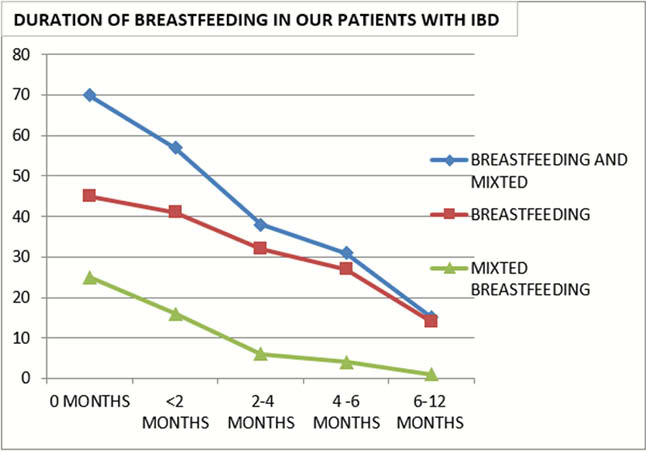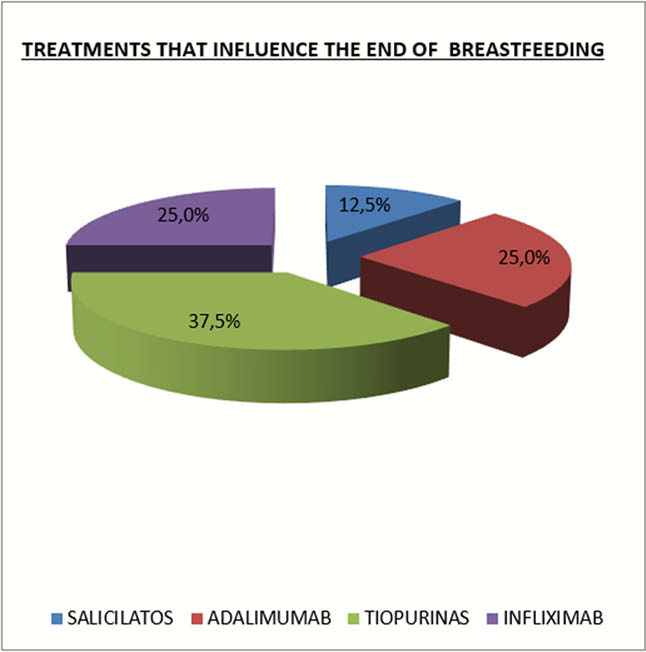P792 Breastfeeding in our patients with inflammatory bowel disease
M. Charro Calvillo1, M. Charro-Calvillo1, E. Peña-Gonzalez2, Y. Ber-Nieto3, M.T. Botella Esteban9, M.J. Alcalá Escriche4, P. Lacarta García9, E. Fernandez Bonilla5, A. Mir Subías6, M.T. Arroyo-Villarino9, E. Lafambra Cabrejas9, J. Nerin De la puerta7, R. Vicente Lidón9, S. García López9, P. Corsino Roche8
1Digestive Unit Hospital de Barbastro, Barbastro, Spain, 2Digestive Unit Hospital Royo Villanova, Zaragoza, Spain, 3Digestive Unit Hospital San Jorge, Huesca, Spain, 4Digestive Unit Hospital Obispo Polanco, Teruel, Spain, 5Digestive Unit Hospital de Alcañiz, Barbastro, Spain, 6Digestive Unit Hospital Ernest LLuch, Calatayud, Spain, 7Digestive Unit Hospital Clínico Universitario, Zaragoza, Spain, 8Hospital Miguel Servet, Zaragoza, Spain, 9carretera nacional 240, Digestive unit, Barbastro, Spain
Background
Breastfeeding is one of the most important environmental factors in early childhood for later development of an Inflammatory Bowel Disease. The duration of lactation is essential for it to have a protective effect. In addition to IBD patients, breastfeeding can have a beneficial effect for preventing disease relapse. For these reasons, we plan to know how lactation develops in our group of patients with Inflammatory Bowel Disease (IBD).
Methods
A retrospective analysis of patients followed by gastroenterology consultations, with established diagnosis of IBD and with at least one gestation, in a period from January 2011 to January 2016. The data were collected a posteriori through two simple questionnaires, one completed by the patient, collecting the type of childbirth and breastfeeding she experienced and factors that influenced it. Another form is filled out by the gastroenterologist recording the characteristics of his inflammatory bowel disease. The data is collected in a structured database in Microsoft Excel and analysed with the SPSS statistic package for Windows.
Results
Data from 78 patients diagnosed with IBD are analysed from eight public hospitals in our autonomous community. 61.1% of patients have ulcerative colitis and 38.9% Crohn’s disease. The deliveries were mainly vaginal (82%), compared with 18% of caesarean-sections, four of them directly motivated by digestive disease. More than half of patients (57.7%) started breastfeeding after childbirth, 10.25% breastfeeding and 32.05% mixed breastfeeding But only 34.6% reach six months of breastfeeding, reaching 39.7% if we include mixed breastfeeding. In 17 patients (21.8%) their base-based inflammatory bowel disease directly influenced the development of lactation. Pharmacological treatment is the main cause for breastfeeding, followed by disease outbreaks, hospitalisations and surgery. Only 47.4% of the patients stated that in the IBD consultation they were given some information about breastfeeding, although almost all replied that they would have liked to receive it.


Conclusion
The majority of patients with inflammatory bowel disease in our consultations, do not reach six months of breastfeeding currently recommended by the World Health Organisation, so we have a great opportunity for improvement in this field and as gastroenterologists, we can contribute by providing more information to our patients about breastfeeding and its relationship with IBD.


